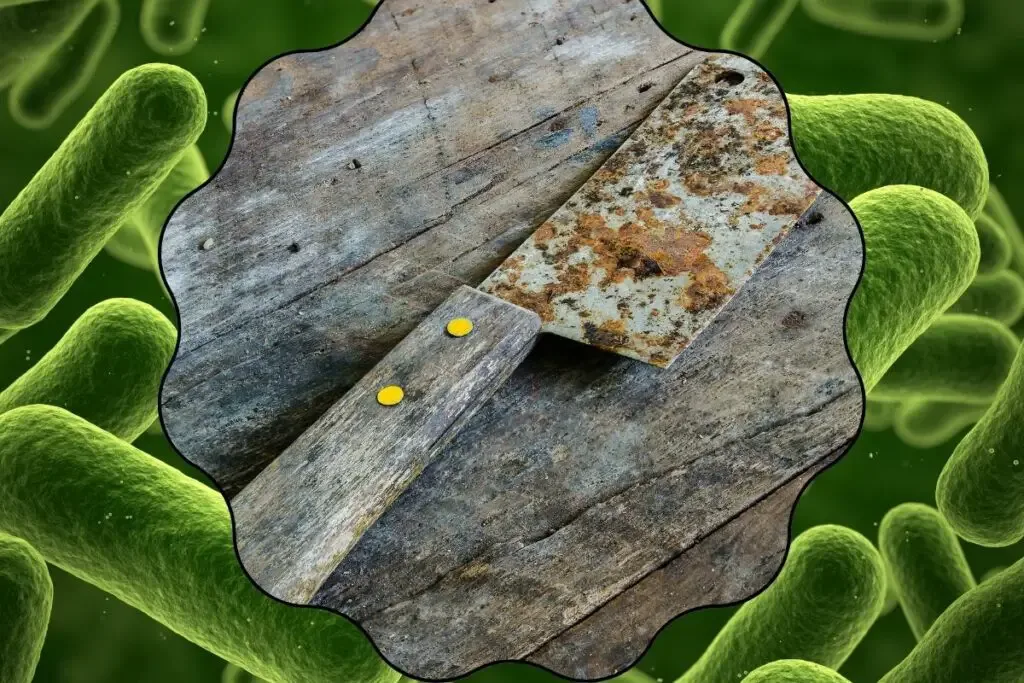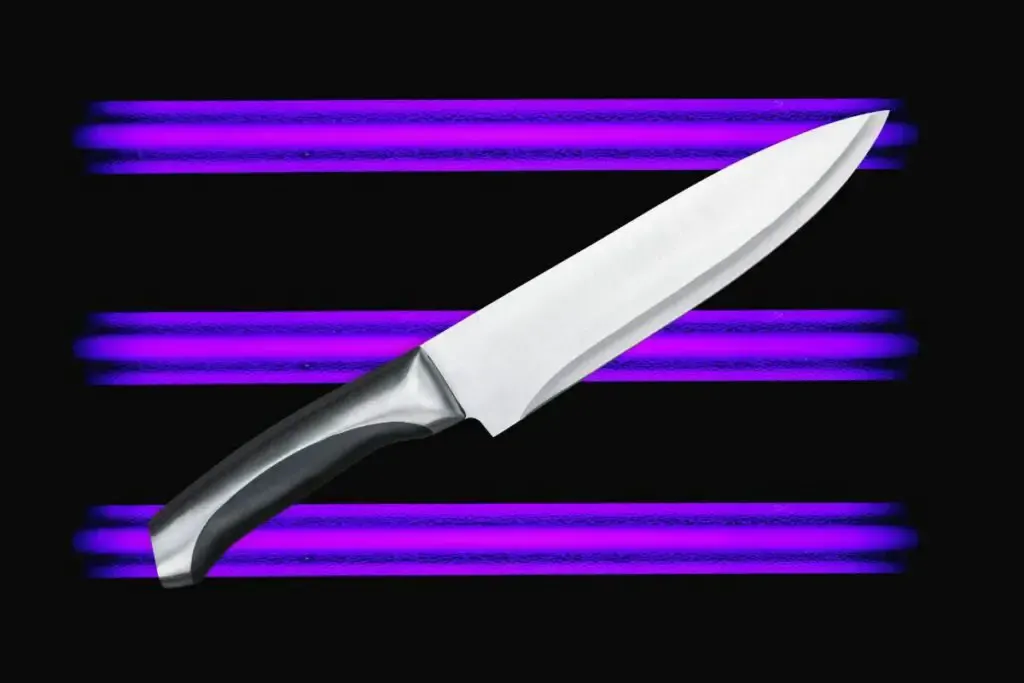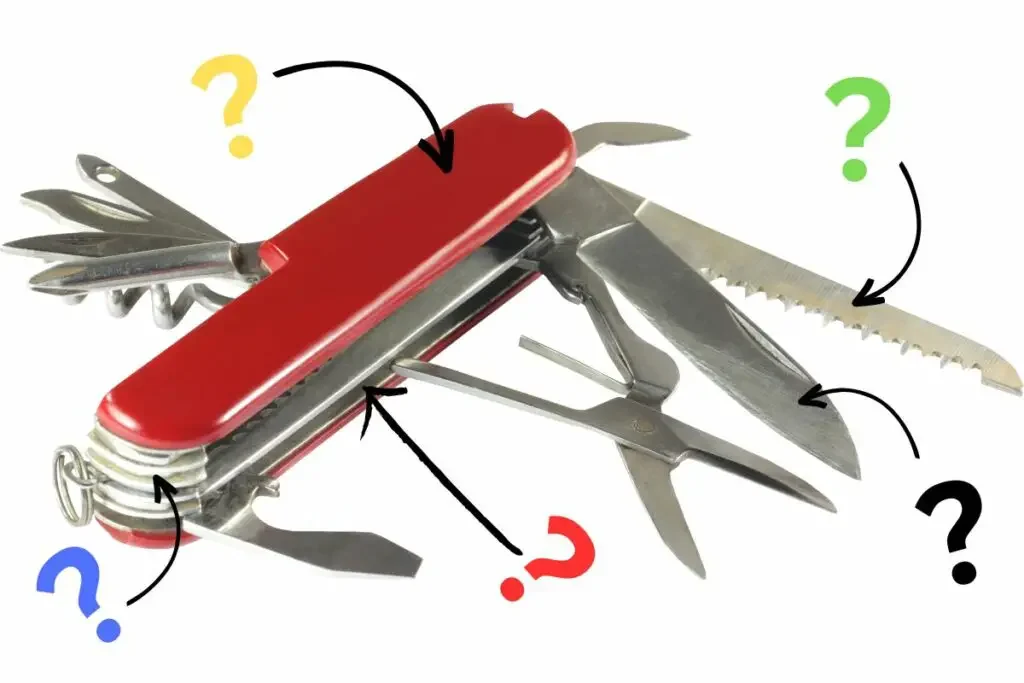As an Amazon Associate, we earn from qualifying purchases with no additional costs for you.
Knives are an essential tool, but keeping your knives clean and sanitized is important for keeping your knives safe to use, especially for preparing food. A dirty knife can pose a health risk if used to prepare food. When and how should a knife be cleaned and sanitized?
A knife should be cleaned after every use, before using it on a different ingredient, and it should be cleaned immediately rather than leaving it overnight. Sanitizing or deep cleaning should be done at least once a month or immediately after using the knife with known contaminants.
We will discuss the importance of keeping knives clean and sanitized and explore the different scenarios in which knives should be cleaned. We’ll also provide step-by-step instructions on properly sanitizing your knives and offer tips for storing them to keep them clean and hygienic.
When To Clean And Sanitize Your Knife

It’s easy to overlook the cleanliness of our knives, especially when we’re in a rush to use them or prepare a meal.
However, failing to keep knives clean and sanitized can lead to the growth and spread of harmful bacteria. These bacteria can cause foodborne illness and have serious consequences, especially for those with weakened immune systems.
The Dangers Of A Dirty Knife
Before we look at when and how to clean a knife, we need to understand the dangers of using a contaminated knife and the potential dangers involved.
First and foremost, keeping knives clean and sanitized is essential for food safety. Knives can be a breeding ground for harmful bacteria, such as Salmonella, E. coli, and Listeria.
These bacteria can be transferred to food through contact with contaminated surfaces and can cause serious illness if ingested.
Using unclean knives can also affect the quality of your food. Bacteria can cause food to spoil more quickly, leading to an unpleasant taste and odor.
Another danger is injuring yourself with a knife contaminated with bacteria. If you accidentally cut yourself with a dirty knife, the bacteria on the blade can access the wound. This can lead to a serious infection in the cut that can take a long time to heal or lead to other health complications.
It’s important to note that simply rinsing a knife with water is not enough to remove bacteria. Bacteria can cling to the surface of a knife and continue to grow and spread even after rinsing.
That’s why it’s important to properly clean and sanitize knives after each use, especially when switching between different types of food.
TIP: Do you have rust on your kitchen knives? Explore our tips to remove rust from your knives and restore a pristine blade!
6 Proven Ways On How To Prevent Rust On Kitchen Knives
When To Clean A Knife

Regularly cleaning your knife is important to keep the blade clean and free of potentially harmful bacteria.
Regular cleaning should be part of your normal knife maintenance, but some situations require additional and sometimes immediate cleaning and sanitizing of your knife.
Clean A Knife After Each Use
One of the easiest ways to keep knives clean and prevent bacterial growth is to clean them after each use.
When you’re finished using a knife, rinse it under hot water to remove any food or other residue. Then, wash the knife with hot, soapy water using a sponge or dishcloth. Pay extra attention to the handle and other hard-to-reach areas, especially where the blade meets the handle.
After washing the knife, rinse it thoroughly under hot water to remove any soap residue, then dry it with a clean towel. Avoid leaving knives to air dry, as this can promote bacterial growth.
It’s also important to avoid cross-contamination when washing particularly dirty knives. Use a separate sponge or dishcloth for your knives used to process raw ingredients to avoid transferring bacteria from one knife to another.
Clean Your Knives When Switching From One Food To Another
When preparing food, it’s important to avoid cross-contamination between different types of food. Knives are used to process almost every ingredient in the kitchen, so it is easy to mistakenly pick up a knife that is already dirty from processing another ingredient and use it on a different food type.
An example is using the same knife to cut raw meat and vegetables, which can spread harmful bacteria from the meat to the vegetables and increase the risk of foodborne illness.
This is of particular concern if the different ingredients are cooked differently. The meat will be cooked at a higher temperature, which is likely to kill any bacteria present in the meat.
However, if the same knife used to cut the raw meat is used to prepare a salad, which will be eaten raw, the bacteria transferred to the salad ingredients can result in food poisoning.
For the same reasons, your should clean your knife when cutting different meats in the kitchen. Do not use the same knife to slice the raw beef after you just used it to cut up pieces of raw chicken.
As a summary and to stress the importance of this rule, it is important to clean your knife when switching from one type of food to another to prevent cross-contamination. This includes switching between different types of meat, as well as switching between meat and vegetables.
To clean your knife, wash it with hot, soapy water and then rinse it thoroughly under hot water. Alternatively, you can sanitize your knife using a bleach solution, but we will discuss this a little later.
Cleaning and sanitizing your knives regularly during food preparation can help prevent the spread of harmful bacteria and keep your kitchen and food safe.
BTW: If you are interested in buying the best cutting board, you can find our recommendations below:
- The best overall: Virginia Kitchen Boys Cutting Board (Amazon link). This fantastic cutting board is made from sustainable walnut wood from the United States and brings almost perfect safety when cutting with your knives.
- Alternative: Yoshihiro Cutting Board (Amazon link). Professional traditional Japanese cutting board that chefs around the world use.
- Cheaper option: Shun Cultery Cutting Board (Amazon link). Another Japanese cutting board stands out, especially for its simplicity and affordable price.
Clean Your Knives Immediately After Use
The best time to clean a knife is immediately after using it. Don’t let a dirty knife sit in the sink overnight.
This allows food particles to harden on the knife and allows the bacteria to flourish and penetrate the knife handle, particularly if the handle is made from natural materials such as wood.
Leaving dirt or food particles on the knife is also not good for the steel. The food particles can promote moisture retention on the blade surface, leading to rust.
Acidic foods can react with the steel blade and stain the knife or cause corrosion and pitting on the steel surface, reducing the lifespan of your knife.
How To Sanitize A Knife

It is important to note that cleaning is not the same as sanitizing. Cleaning is everyday maintenance while sanitizing is a deep clean that can be performed periodically or as needed on your knives.
Sanitizing is a method of cleaning that removes more bacteria than washing with hot soapy water. Sanitizing can be done after the knife has been used for a particularly dirty job or once a month as a preventive cleansing.
Sanitize Your Knife Using A Bleach Solution
A bleach solution is one of the most effective ways to sanitize knives. Mix 1 tablespoon of unscented household bleach with 1 gallon or 4.5 liters of water to make a bleach solution. Immerse the knife in the solution and let it soak for at least one minute.
After soaking, rinse the knife under hot water to remove any bleach residue, then dry it with a clean towel. Be sure to avoid using a bleach solution on knives with wooden handles, as it can cause the wood to warp or discolor.
TIP: Patina on a knife is not dirt, and can protect the steel from corrosion. Should you force a patina on your blades, or let it happen naturally? Find out all the information in our article below:
Patina On A Knife: Prevent Or Force It? In-Depth Explanation
Use Ultraviolet Light To Sanitize Your Knives
Relatively new products on the market use the disinfecting properties of ultraviolet or UV light to sanitize many household items, including knives.
UV light has long been known to be a germ killer and to render microorganisms inactive. The energy frequency in UV light can destroy the ability of microorganisms to reproduce, rendering them inactive or killing the microbes outright.
UV light has been used to disinfect surgical instruments and other equipment in the medical field, and this technology is now available to clean your knives at home.
Two products I can recommend that can sanitize your knives with UV light are the Doctors Choice Sanitizer Box and the UV Portable Knife Holder (Amazon links).
The Doctor’s Choice Sanitizer Box is a good option if you also want to sanitize other household items besides your knives. You must ensure that the box is large enough to accommodate your knives.
The UV Portable Knife Holder is designed for knives and other cutlery and has the added feature of fast-drying your knives with warm air. This unit is only designed for kitchen implements and cannot be used for other items.
Sanitize Your Knife Using An Alcohol-Based Sanitizer
Another option for sanitizing knives is to use a commercial alcohol-based sanitizer. These products are widely available and can be found at most grocery stores or online retailers.
A useful sanitizing product you can use is an odorless spray hand sanitizer with an alcohol content of 80% or higher.
These sanitizers are safe to use on all parts of the knife, including the handle, to kill most germs and bacteria. After sanitizing, rinse the knife under hot water to remove any residue, then dry it with a clean towel.
Sanitize Your Knife In Boiling Water
Boiling water is another method of sanitizing a knife and cleaning the hard-to-reach gaps and crevices. Using this method on knives with wood handles is not recommended, as the wood can be damaged by immersion in hot water.
To use this method, heat water on the stove in a pot or a pan large enough to accommodate your knife. Once the water is boiling, submerge the knife for at least 1 minute. This will effectively kill germs and bacteria on the knife.
Use a pair of tongs to put the knives in the boiling water and retrieve them once the 1-minute time limit is up.
What Parts Of A Knife Should Be Cleaned And Sanitized?

The blade and the handle should be sterilized to ensure the entire knife is bacteria-free and clean. The knife handle can transfer contaminants to your hands, which can be transferred to the food when you handle the ingredients.
This is why hard, fine-grained wood is best for a knife handle. There are fewer gaps between the grains for bacteria to penetrate. The finish on the wood is also important to repel wet food juices and prevent the wood from absorbing these contaminants.
Wood knife handles are best cleaned with soap and hot water and sanitized with an alcohol-based sanitizer or a UV sterilizer.
Bleach solutions are not recommended on wood handles because the bleach can discolor the wood and strip the finish from the handle.
In contrast, synthetic knife handles can usually be cleaned with any of the mentioned cleaning and sanitizing methods.
Tip For Cleaning Folding Knives
A folding knife, such as a pocket knife, typically has more places for dirt and bacteria to accumulate on the knife.
A particular area of concern for these knives is the pivot point of the blade. As you open the blade, check the picot point to see the dirt exposed as the blade rotates.
The best method I have found to clean this area is to use a toothbrush with an alcohol-based sanitizer.
After cleaning this area of the folding knife, you should lubricate the pivot to keep it functioning smoothly.
How To Store Knives To Keep Them Clean And Sanitized
Properly storing your knives is another important step in keeping them clean and sanitized. I have listed some tips that can help keep your knives clean in storage.
- Use a knife block or magnetic strip. One of the most convenient and easiest ways to store knives is to use a knife block or magnetic strip. These storage options keep knives within reach while also protecting them from damage and preventing cross-contamination.
- Keep knives separate from other utensils. Keeping your knives separate from other utensils is important to prevent cross-contamination. This means avoiding storing knives in a utensil drawer, where they can contact other utensils and potentially spread bacteria.
- Clean and sanitize storage options regularly. No matter what type of storage option you choose, it’s important to clean and sanitize it regularly to prevent the growth of bacteria. This means washing the knife block or magnetic strip with hot, soapy water and then sanitizing it with a bleach solution or commercial sanitizer.
- Protect the blades. In addition to preventing cross-contamination, it’s important to protect the blades of your knives during storage. Blade guards or sheaths can help prevent the blades from becoming dull or damaged over time. When using blade guards or sheaths, choose the ones that fit your knives properly and are made of durable material.
Properly storing your knives can help prevent cross-contamination, protect the blades, and keep them clean and sanitized. This can also help extend the life of your knives and prevent them from becoming damaged or dull over time.
Conclusion
Keeping your knives clean and sanitized is crucial for maintaining a safe and healthy kitchen environment and keeping your knife clean enough to process food safely. Regularly cleaning and sanitizing your knives can help prevent the spread of harmful bacteria and reduce the risk of foodborne illness.
Remember, it’s not just about cleaning and sanitizing your knives after each use but also properly storing them to keep them clean and safe for future use. By following these tips and making knife cleaning and sanitizing a regular part of your knife care routine, you can ensure that your knives stay in top condition and your food is safe to eat.
TIP: How do you know when your knives are beyond help and should be replaced? Follow our guidelines to replacing your knives when the time is right!
5 Signs You Need to Replace Your Kitchen Knife + How Often
